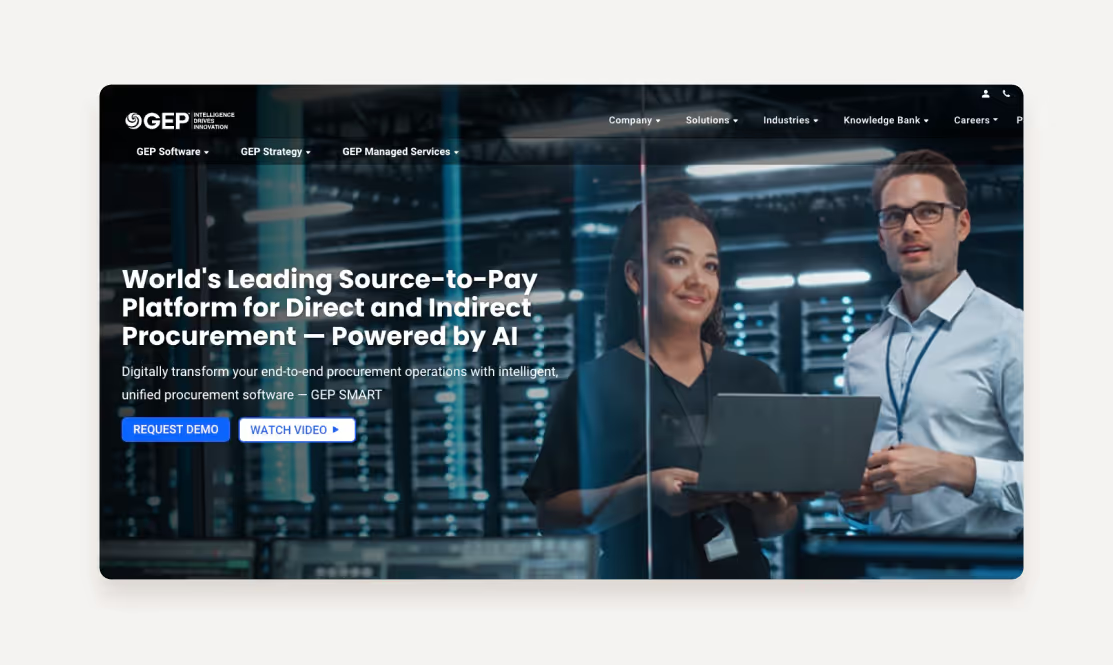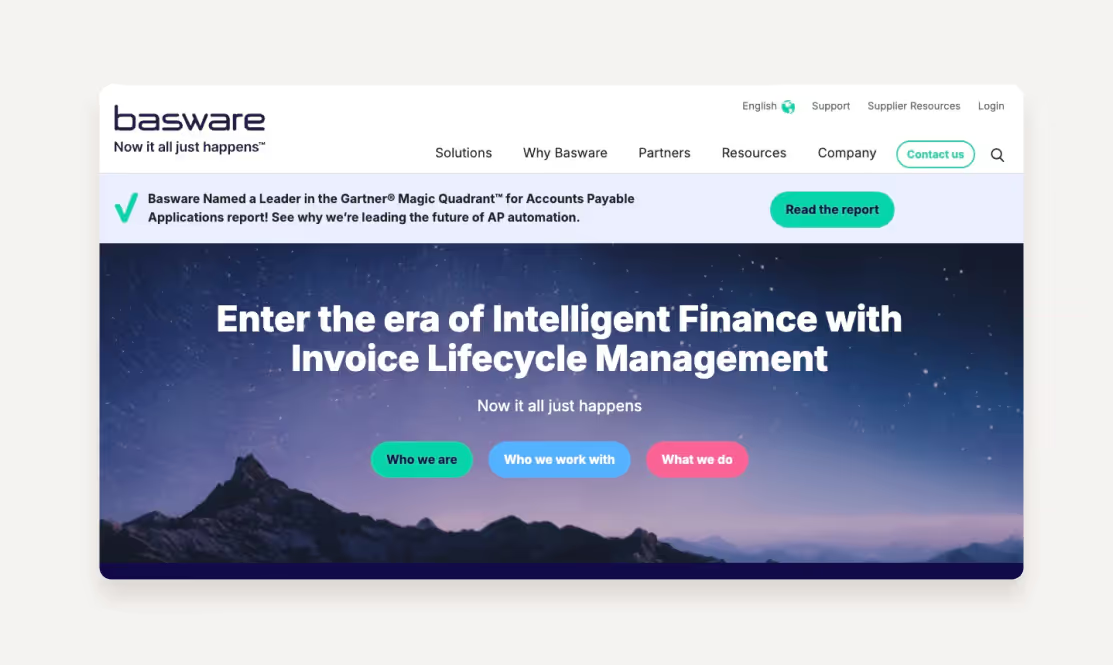Solutions
Customer Support
Resources
Procurement teams have a lot on their plates – move faster, cut costs, stay compliant... and still find time for lunch.
Thankfully, the right tools can help.
From intake to invoice, the best procurement solutions eliminate bottlenecks and bring structure to complex workflows. The procurement software market is currently worth $9.82 billion, and it’s expected to grow at just under 10% per year between now and 2030. What’s more, procurement software spend is growing steadily, with budgets up by 5.6 per cent in 2025.
Of course, more budget doesn’t always mean better outcomes – it depends on how you use it. This guide breaks down the top procurement tools for modern teams and explains how to choose the right solution for your needs.
Procurement software helps businesses manage how they buy from suppliers – from sourcing and contract signing to invoicing and tracking spend. The best tools bring structure to messy processes, reduce manual work, and give teams visibility across the entire procurement lifecycle.
Most platforms fall into one or more of these areas:
Some tools focus on one part of the process. Others aim to cover it end-to-end, optimizing each of your procurement team’s KPIs. Either way, the right software helps procurement, legal, finance, and ops work together – without relying on email chains, spreadsheets, or disconnected systems.
Procurement tech has had its glow-up – it’s getting faster and more useful with every year. From AI to integrations, these trends show how leading platforms are simplifying compliance in 2025.
Generative AI is at the heart of procurement operations, automating intake, flagging risk, and reducing approval delays. With some organizations seeing 25 per cent productivity improvements thanks to AI, it’s no wonder that 89 per cent of procurement leaders are now prioritising GenAI (up from just 16 per cent last year).
The best tools don’t just serve procurement. They let business users initiate purchases safely, with guardrails built in. That means smarter templates, clearer workflows, and fewer blockers.
Procurement, legal, finance, and ops need shared context. The best tools don’t operate in silos – they connect seamlessly with ERPs, CRMs, CLMs, and spend platforms.
Businesses want a live view of supplier risk, including ESG exposure, delivery delays, or financial instability. According to Gartner, 82 per cent of compliance failures in the past year were linked to third-party risks – a challenge procurement is now expected to help solve.
Looking to invest in procurement software this year? Here’s a shortlist of tools leading the pack today – including what each one does best, and where it fits in the wider procurement stack.
Here’s a closer look at how each platform stacks up – and what makes them stand out.
SAP Ariba Central Procurement is a comprehensive procurement platform that supports sourcing, purchasing, and supplier collaboration at scale. It’s a strong fit for large enterprises that need to manage complex supplier ecosystems.

What sets SAP Ariba apart is its integration with the SAP Business Network, which makes supplier onboarding and collaboration easier. Features like guided buying and automated policy controls help procurement teams stay compliant and efficient – without relying on manual checks.
“SAP Ariba offers a comprehensive set of procurement features but comes with a steep learning curve.” Independent review, G2
“The interface is well designed and although it can be a bit complex and intimidating at first, it is a nice tool that allows for orderly and agile work.” Independent review, Capterra
Coupa is a unified spend management platform that helps businesses gain control over procurement, invoicing, and expenses. Its AI-powered workflows guide employees through compliant purchases while giving procurement teams full visibility across spend.

Coupa is a strong choice for mid-size and large organisations that want to automate approvals, track budgets in real time, and reduce rogue spend – all from one central system.
“Fast, reliable, and easy to navigate, User-friendly and improves spending control.” Independent review, G2
“This is an extremely powerful and well-orchestrated product.” Independent review, Capterra
Juro is a contract automation platform built for legal and business teams, including procurement. It replaces Word, PDFs, and email with a single workspace where teams can create, negotiate, approve, and sign supplier contracts up to 10x faster.
Procurement teams use Juro to streamline NDAs, MSAs, SOWs, and other vendor agreements. With features like readymade contract templates, approval workflows, and real-time contract collaboration capabilities, it reduces bottlenecks and makes contracting faster and more transparent.
{{quote1}}
“Juro has been such a fantastic tool for streamlining our contract process and making both the team and wider company more efficient.” Independent review, G2
“Juro makes the life for our legal and sales teams significantly easier. We've cut down the time taken to create a contract by 96% and also made tracking of signatures much more visible.” Independent review, Capterra
To find out more about how Juro enables legal and procurement teams to automate routine contract admin, negotiate contracts effortlessly, and regain visibility into agreements, hit the button below.
GEP SMART is a cloud-native procurement platform that covers the entire source-to-pay cycle. It integrates features like spend analysis, sourcing, contract management, and supplier management into a single solution. The platform also provides AI-driven analytics, helping procurement teams optimize their strategies and drive cost savings.
“Friendly user interface, anyone can use it without problem.” Independent review, G2
“The GEP customer success team listens to their customers and creates enhancements based on the feedback of their customers. Software is always improving.” Independent review, Capterra

Basware specializes in automating the accounts payable process, streamlining invoice capture, matching, and payment. Its platform supports touchless invoice processing, which reduces manual intervention and accelerates payment cycles across global supplier transactions.

“Super user-friendly platform, easy to train others with. Love the smart-coding feature which saves a lot of time.” Independent review, G2
“The dashboard is very helpful and eye catching. Love the way the software shows all the contents and very easy to find what you required.” Independent review, Capterra
If you’re looking to buy procurement software, then the options listed above are a great start. But here’s the catch – you still have to figure out what’s best for your team. There’s little point in selecting a tool that doesn’t fit your workflows or connect with your existing systems.
Below, we’ll explain the key areas you need to consider when evaluating potential tools.
P.S. Want to discover more tips on how to evaluate potential vendors? Check out our article on how to become a sophisticated buyer.
Can the tool connect easily with your ERP, finance system, contract platform, and approval workflows? Procurement doesn’t operate in isolation – your software shouldn’t either. Look for tools that integrate seamlessly with your other tools.
How easy is it to tailor the tool to your processes? The best platforms don’t require heavy customization or IT support – they’re configurable out of the box.
Procurement software should work for more than just procurement. Legal, finance, IT, and business users all need to engage with the system. If it’s clunky or doesn’t fit a team’s workflows, then they probably won’t use it.
What kind of insight does the tool provide? Look for dashboards that show real-time progress, bottlenecks, supplier risk, and spend.
Contracting shouldn’t feel like untangling a set of headphones. Choose a platform that lets teams generate contracts quickly, route them for approval, and track every change – all in one place.
How long does it take to implement and start seeing results? Some tools take months to configure, while others work out of the box. Look for platforms with fast onboarding and clear ROI.
Manual contract processes slow everything down – chasing approvals, digging through inboxes, switching between Word and PDFs. Juro fixes that.
With Juro, procurement teams can create supplier contracts in minutes using smart templates, route them for approval, negotiate live in-browser, and sign – all in one place. No more email ping-pong. No more version chaos.
Every contract lives in a single, searchable workspace. That means it’s easy to track progress, flag risks, and stay ahead of renewals. Whether it’s an NDA, MSA or SOW, Juro helps you get to ‘yes’ faster – and with less friction.
{{quote2}}
Procurement teams iin 2026 are under more pressure than ever to move faster, reduce risk, and prove value. The right software can make that possible, but only if it fits how your team actually works.
Whether you need help with intake, sourcing, contracting or payments, there’s no shortage of tools on the market. The challenge is picking the one that doesn’t just check boxes, but helps you get work done.
If contract workflows are slowing down your procurement process. Our AI-powered platform replaces manual steps with smart templates, approvals, and real-time collaboration – all in one workspace.
Fill in the form below to see how Juro can streamline your procurement contracts and help your team move faster.
Lorem ipsum dolor sit amet, consectetur adipiscing elit. Suspendisse varius enim in eros elementum tristique. Duis cursus, mi quis viverra ornare, eros dolor interdum nulla, ut commodo diam libero vitae erat. Aenean faucibus nibh et justo cursus id rutrum lorem imperdiet. Nunc ut sem vitae risus tristique posuere.

